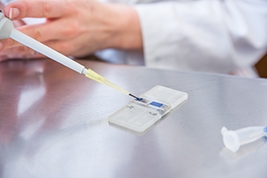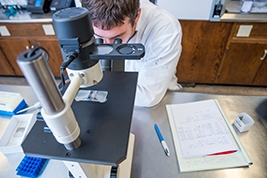Funded by a 3.6 million dollar grant through the California Institute of Regenerative Medicine (EDUC2-12620), our two-step program is designed to train students for careers in stem cell biology and regenerative medicine.
California Institute of Regenerative Medicine website
Part 1: Humboldt CIRM 3.0 Pre-Internship Training Program
Accepted students will participate in the 5-week hybrid course BIOL 544L Stem Cell Biology Lab during the first Humboldt summer session. Humboldt professors and research scientists from our host institutions will introduce the trainees to foundational principles, current topics and research methods in the fields of stem cell biology and regenerative medicine; provide one-on-one training in best laboratory practices in molecular biology and mammalian cell culture; and facilitate a workshop in bioinformatics and computational biology. In addition, the trainees will be mentored through the internship application process. The goal is for all trainees to be placed in their host internship laboratory by the end of the pre-internship training program.
The cost of BIOL 544L tuition and $700.00 in housing costs are covered by the Humboldt CIRM Bridges Award.
Part 2: Humboldt CIRM 3.0 Bridges Internship
The 12 month Humboldt CIRM 3.0 Bridges internship is comprised of six primary components:
A full time, mentored research experience where trainees participate in hands-on, regenerative medicine-related research involving stem cells, gene therapy and/or other critical research relevant to understanding and treating a human condition or disease. Students may intern in laboratories at Cedars-Sinai Board of Governors Regenerative Medicine Institute, The Stanford University Institute for Stem Cell Biology and Regenerative Medicine, The University of California Davis Stem Cell Program, or Takeda California. Trainees are expected to work 40 hrs./week in their host laboratory from September 1st-July 31st.
- Mentoring and Career Development Curricular Activities. Three course units/semester will be dedicated to research design, execution, analysis, and communication (RDEAC). Nine course units/semester are dedicated to experiential learning and professional development (ELPD). Activities include a laboratory course in advanced cell culture techniques and three courses offered by the Regulatory Affairs Professional Society: Good Clinical Practice, Good Laboratory Practice, and Good Manufacturing Practice.
Patient (or Patient Advocate) and Healthcare Engagement Activities designed to engage trainees with patients/patient advocates and provide insights into the challenges of developing new cell therapies and drugs. These activities will occur both at the internship host institutions and in Humboldt County. Humboldt County activities will be designed in collaboration with the Humboldt-Del Norte County Medical Society and the Humboldt del Norte Pre-Medical Education Task Force (HUMPET).
Community outreach and education activities designed to create opportunities for students to educate the community about stem cells, gene therapy, and the promise of regenerative medicine. These activities will occur both at the internship host institutions and in Humboldt County. Humboldt County activities will be designed in collaboration with the Humboldt-Del Norte County Medical Society and the Humboldt Del Norte Pre-Medical Education Task Force (HUMPET).
Participation in the Annual CIRM Bridges Meeting. All CIRM Bridges students throughout the state convene for an annual conference each July. Each trainee is expected to present a research poster summarizing their work.
All trainees will receive a cost of living stipend of $3,000/month during the 12 month internship and $8,000 to cover tuition and fees for the academic year. Travel costs associated with the Annual CIRM Bridges meeting are also covered by the grant.


